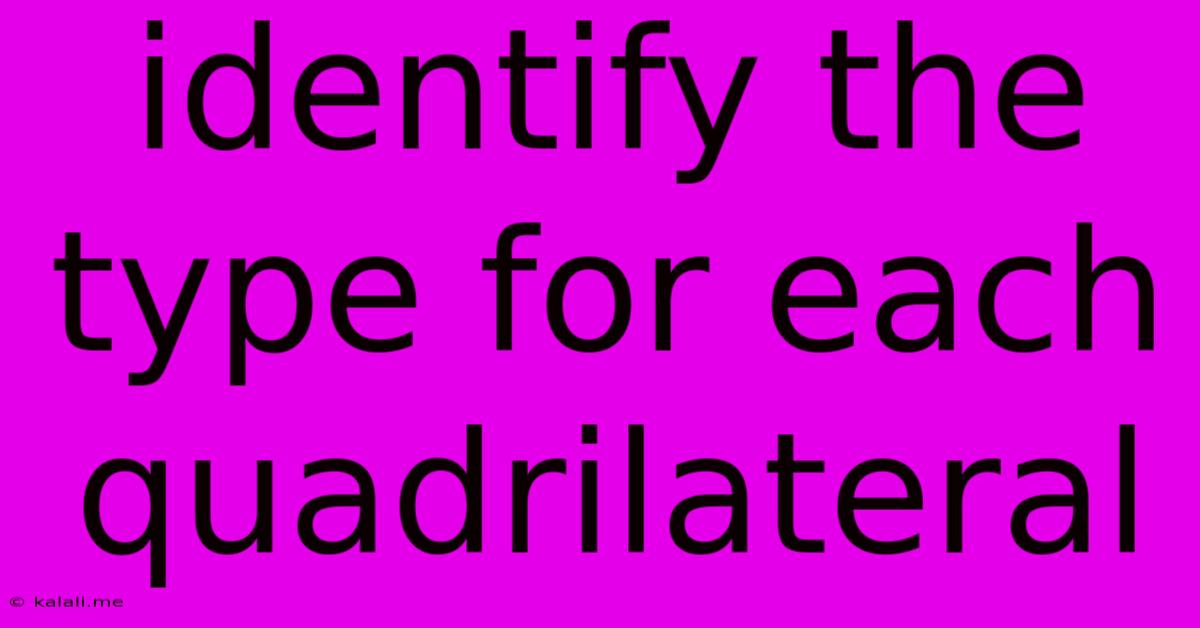Identify The Type For Each Quadrilateral
Kalali
May 10, 2025 · 3 min read

Table of Contents
Identifying Quadrilateral Types: A Comprehensive Guide
Understanding the different types of quadrilaterals is fundamental in geometry. This article will provide a comprehensive guide to identifying various quadrilaterals based on their properties, helping you confidently classify these four-sided polygons. We'll delve into the key characteristics that distinguish each type, making the process clear and easy to understand.
What is a Quadrilateral?
A quadrilateral is simply a polygon with four sides. Many different types of quadrilaterals exist, each with unique properties related to their sides, angles, and diagonals. These properties allow us to categorize and classify them.
Key Properties to Identify Quadrilaterals
Before we dive into specific quadrilateral types, let's review the essential properties we'll be using for classification:
- Sides: Are the sides equal in length? Are any sides parallel?
- Angles: Are the angles right angles (90 degrees)? Are opposite angles equal? Are consecutive angles supplementary (add up to 180 degrees)?
- Diagonals: How do the diagonals intersect? Are they equal in length? Do they bisect each other?
Types of Quadrilaterals
Now let's explore the common types of quadrilaterals:
1. Parallelogram:
- Definition: A parallelogram is a quadrilateral with two pairs of parallel sides.
- Properties: Opposite sides are equal in length, opposite angles are equal, and consecutive angles are supplementary. Diagonals bisect each other.
- Examples: Rectangles, rhombuses, and squares are all special types of parallelograms.
2. Rectangle:
- Definition: A rectangle is a parallelogram with four right angles.
- Properties: Opposite sides are equal in length, all angles are 90 degrees, and diagonals are equal in length and bisect each other.
3. Rhombus:
- Definition: A rhombus is a parallelogram with all four sides equal in length.
- Properties: Opposite angles are equal, consecutive angles are supplementary, and diagonals are perpendicular bisectors of each other.
4. Square:
- Definition: A square is a quadrilateral that is both a rectangle and a rhombus.
- Properties: All four sides are equal in length, all four angles are 90 degrees, and diagonals are equal in length, perpendicular, and bisect each other. It possesses all the properties of parallelograms, rectangles, and rhombuses.
5. Trapezoid (Trapezium):
- Definition: A trapezoid is a quadrilateral with at least one pair of parallel sides.
- Properties: The parallel sides are called bases, and the non-parallel sides are called legs. Isosceles trapezoids have equal legs and equal base angles.
6. Kite:
- Definition: A kite is a quadrilateral with two pairs of adjacent sides that are equal in length.
- Properties: One pair of opposite angles are equal. The diagonals are perpendicular, and one diagonal bisects the other.
Identifying Quadrilaterals: A Step-by-Step Approach
To accurately identify a quadrilateral, follow these steps:
- Count the sides: Ensure it's a four-sided polygon.
- Check for parallel sides: Are any pairs of sides parallel?
- Measure side lengths: Are all sides equal? Are any pairs of adjacent sides equal?
- Measure angles: Are all angles right angles? Are opposite angles equal?
- Examine diagonals: How do the diagonals intersect? Are they equal in length?
By systematically examining these properties, you can correctly classify any quadrilateral.
Conclusion
Understanding the characteristics of different quadrilaterals is crucial for geometric problem-solving. This guide provides a solid foundation for identifying parallelograms, rectangles, rhombuses, squares, trapezoids, and kites. Remember to systematically check the properties of each quadrilateral to make accurate classifications. With practice, identifying these shapes will become second nature.
Latest Posts
Latest Posts
-
How Many Tenths Are In An Inch
Jul 15, 2025
-
Which Word Has The Most Positive Connotation
Jul 15, 2025
-
How Do I Send An Evite Reminder
Jul 15, 2025
-
When Performing A Self Rescue When Should You Swim To Shore
Jul 15, 2025
-
How Many Decaliters Are In A Liter
Jul 15, 2025
Related Post
Thank you for visiting our website which covers about Identify The Type For Each Quadrilateral . We hope the information provided has been useful to you. Feel free to contact us if you have any questions or need further assistance. See you next time and don't miss to bookmark.